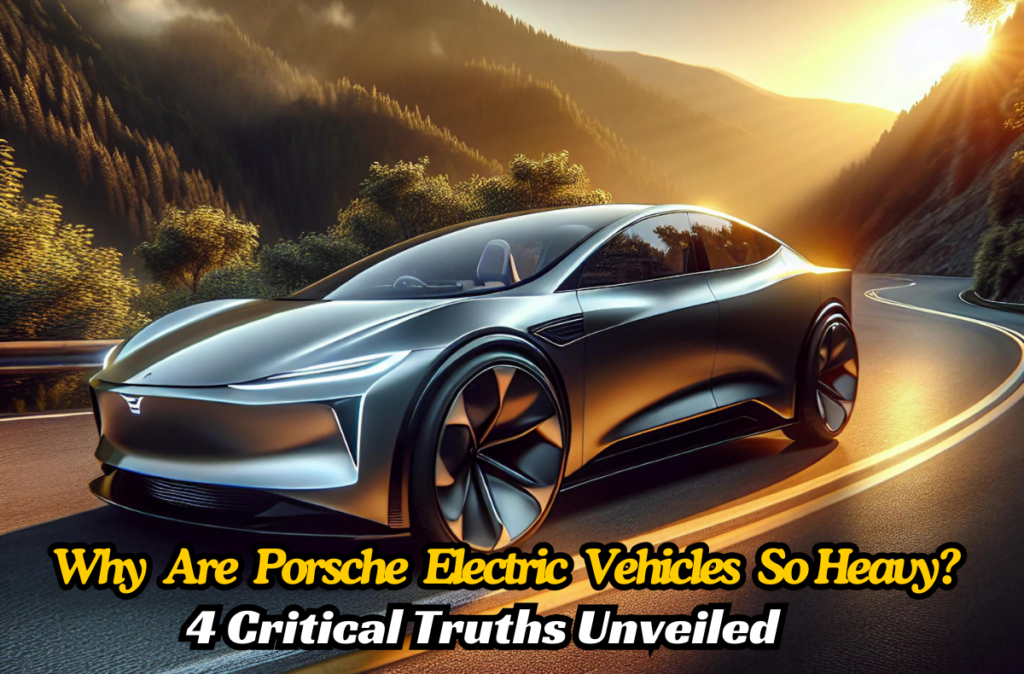Porsche is well-known for building high-performance sports vehicles, and today, it’s also causing buzz in the electric vehicle (EV) market. Among the brand’s premier electric cars, the Porsche Taycan has impressed fans with its speed, technologies, and environmental friendliness. One often-asked question, though, is: Why are Porsche electric vehicles so heavy?
Here, we will investigate the several elements influencing Porsche EV weight, how this weight affects performance, and future developments in lowering electric vehicles‘ total mass.
Factors that Influence Porsche Electric Vehicles
1. Role of Lithium-Ion Batteries
One of the primary reasons Porsche Electric vehicles are so heavy is because they use lithium-ion battery packs. Heavy elements, including lithium, nickel, and cobalt, are used to make up lithium-ion batteries. These dense materials increase weight, but they offer excellent energy storage.
Porsche’s battery packs are also big in size. The Taycan Turbo S has a 93.4 kWh capacity. About 1,389 pounds (630 kg), the Taycan’s battery alone makes up about half of the car’s overall weight. Porsche Taycan Turbo S weighs about 5,121 pounds (2,323 kg).
larger batteries = Greater weight
2. Safety Features and Structural Reinforcement
Extra protection is needed for EV batteries to guarantee they remain unharmed in a collision. This demand for improved safety aspects contributes to the car more weight. The battery is housed in a rigid frame, ensuring it remains intact during accidents.
Porsche incorporates advanced crumple zones and high-strength materials to protect passengers and battery packs in collisions. Electric vehicles are built with a low center of gravity, which improves stability and includes a more substantial frame to safeguard the physical condition of the battery.
3. Performance Motors and Cooling Systems
Porsche EVs, like the Taycan, are designed for performance. Porsche equips these vehicles with powerful electric motors contributing to the car’s weight and allowing it to achieve blistering speeds.
High-performance motors are larger and heavier. Porsche includes advanced cooling systems to prevent overheating, adding even more weight. Despite its heavy weight, the Porsche Taycan Turbo S generates up to 750 horsepower, allowing it to reach 0-60 mph in just 2.6 seconds.
4. Luxurious Materials and Features
Porsche is well-known for its luxury, and its electric vehicles are no exception. While adding weight, the mix of high-end materials and tech systems inside the cabin guarantees the opulent feel Porsche buyers demand.
Porsche employs luxury materials in the cabin but combines lightweight elements like carbon fiber and aluminum in key locations. Infotainment systems and other electronics might weigh the vehicle three hundred pounds (136 kg).
How Does Weight Affect Porsche EV Performance?
Weight vs. Performance Trade-offs
One might think a heavy car would suffer in performance, but Porsche has cleverly engineered its EVs to ensure weight doesn’t compromise driving dynamics.
Instant Torque and Low Center of Gravity
- Instant Torque: Electric motors deliver instantaneous torque, compensating for the added weight.
- Battery Placement: Placing the battery low improves the car’s center of gravity, enhancing cornering and stability.
Performance Metrics:
- Taycan’s top speed is 162 mph (260 km/h).
- The Porsche Taycan offers an estimated 200 to 227-mile range (depending on the variant).
Weight Distribution and Driving Dynamics
Porsche has mastered weight distribution, ensuring the heavy battery pack and components are balanced for optimal driving.
Weight Helps Handling
- Balanced Weight Distribution: The battery placement between the axles ensures near 50/50 weight distribution, a hallmark of great handling in sports cars.
- Enhanced Stability: The lower center of gravity due to battery placement improves cornering and high-speed stability.
The Porsche Taycan has a 49:51 weight distribution, contributing to its excellent handling.
Future Developments in Porsche Electric Vehicles
Battery technology is evolving rapidly, and Porsche is expected to adopt lighter, more efficient options.
Future electric vehicles may incorporate solid-state batteries, which offer higher energy density and weigh less. Lightweight Materials: Increased use of carbon fiber, aluminum, and other lightweight composites is expected in upcoming models.
Predictions:
- Solid-state batteries could reduce battery weight by 30-50%, offering the same energy output in a smaller, lighter package.
- As technology advances, Porsche will likely introduce lighter EV models within the next decade.
Conclusion
Porsche electric cars are generally heavy because of their giant battery packs, safety elements, high-performance motors, and luxurious materials. Although weight could appear to be a drawback, Porsche engineers have developed a driving experience that uses mass, enhancing handling, stability, and acceleration.
As materials and battery technologies develop, future Porsche EVs should be lighter without sacrificing the exciting driving qualities Porsche is renowned for.
FAQs
Why are electric Porsche vehicles heavier than gasoline-powered cars?
Porsche electric vehicles are heavier primarily due to the high-performance motors, stronger safety structures, and big lithium-ion batteries.
Does the speed of Porsche electric cars depend on weight?
The extra weight of Porsche EVs will slow acceleration but won’t reduce its top speed. Porsche EVs have a low center of gravity that improves stability and control and quick torque from electric motors, overcoming their weight.
Do electric cars weight more than conventional cars?
Indeed, the big battery packs electric cars carry cause them to be heavier on average.
Are future Porsche Electric Vehicles lighter?
Indeed, developments in solid-state battery technologies and the application of lightweight materials like carbon fiber should help to lower the weight of the next Porsche electric vehicles.
Is a drawback in Porsche Electric Vehicles their weight?
Not definitely. The additional weight enhances handling and stability, particularly with Porsche’s professional engineering in weight distribution and battery location.
